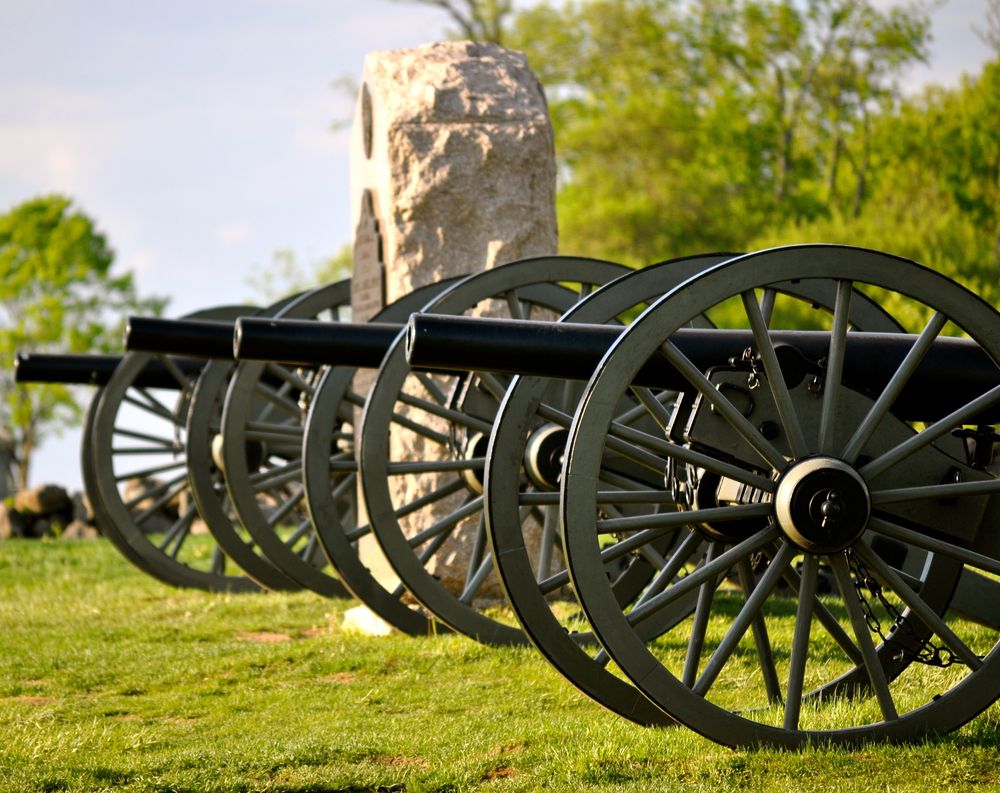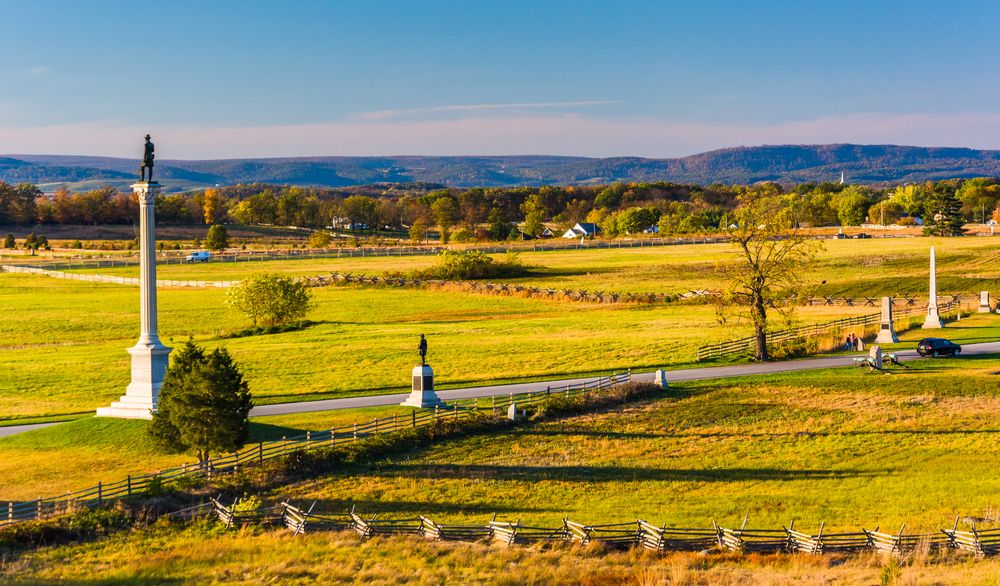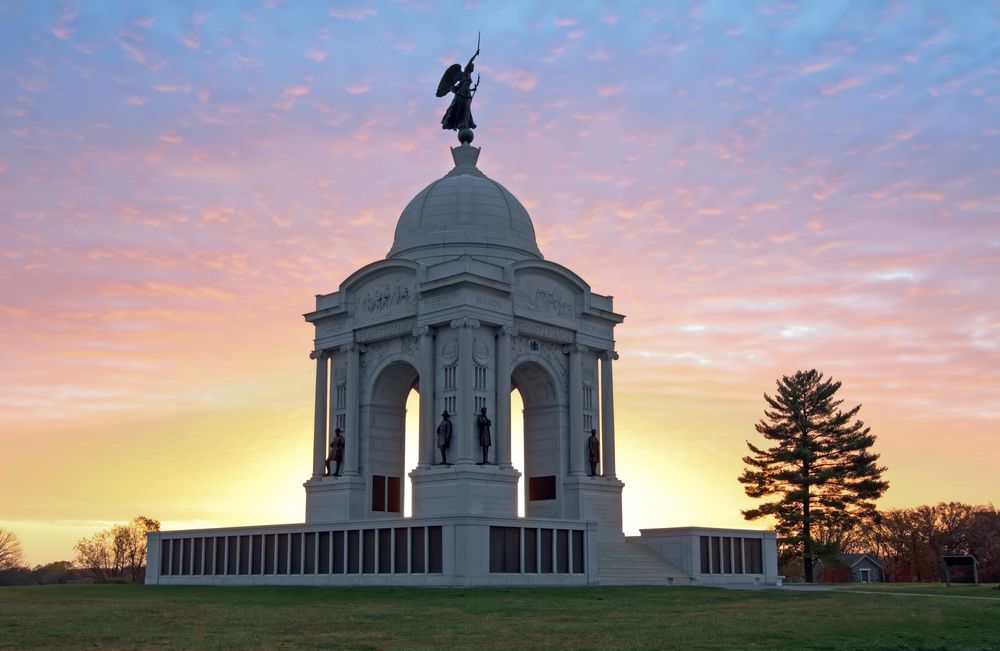Gettysburg National Military Park in Pennsyvlania preserves the grounds of the bloodiest battle of the American Civil War in July 1863 and the inspiration of President Abraham Lincoln’s Gettysburg Address. Many consider it to be the turning point of the Civil War.




Where is Gettysburg?
Gettysburg is a historic town located in Adams County, Pennsylvania, in the United States. It is approximately 80 miles north of Washington, D.C., and about 40 miles southwest of Harrisburg, the state capital.
How many died at Gettysburg?
The Battle of Gettysburg was one of the bloodiest battles of the American Civil War, with total casualties exceeding 50,000 soldiers. Here’s a breakdown of the casualties:
Union Forces: Approximately 23,049 casualties, including 3,155 dead, 14,529 wounded, and 5,365 missing or captured.
Confederate Forces: Approximately 28,063 casualties, including 3,903 dead, 18,735 wounded, and 5,425 missing or captured.
The high number of casualties and the Union victory at Gettysburg marked a turning point in the war, halting General Robert E. Lee’s invasion of the North and boosting Northern morale.
What happened at Gettysburg in the Civil War?
The Battle of Gettysburg, fought from July 1 to July 3, 1863, was one of the most significant and bloodiest battles of the American Civil War. Here’s a brief overview of what happened:
First Day (July 1): The battle began when Confederate forces, under General A.P. Hill, encountered Union troops near Gettysburg. The Confederates pushed the Union forces back through the town to Cemetery Hill and Culp’s Hill1.
Second Day (July 2): Both sides reinforced their positions. The Confederates attacked the Union left flank at Little Round Top, Devil’s Den, and the Wheatfield, while General Longstreet attacked the Union right at the Peach Orchard and Cemetery Ridge1. The fighting was intense and resulted in heavy casualties on both sides.
Third Day (July 3): The most famous action of the battle was Pickett’s Charge, where approximately 15,000 Confederate troops led by General George Pickett attempted to break the Union center at Cemetery Ridge. The charge was repulsed with devastating losses for the Confederates1.
Outcome: The Union Army, under General George G. Meade, successfully repelled the Confederate attacks and held their positions. The Confederate Army, led by General Robert E. Lee, was forced to retreat back to Virginia1. The battle resulted in approximately 50,000 total casualties, making it the bloodiest battle of the Civil War.
Why did Confederates lose Gettysburg?
The Confederates lost the Battle of Gettysburg for several reasons:
Union Defensive Positions: The Union forces, under General George G. Meade, occupied strong defensive positions on Cemetery Ridge, Cemetery Hill, and Culp’s Hill. These positions provided a significant advantage, making it difficult for Confederate forces to break through.
Pickett’s Charge: On the third day of the battle, Confederate General Robert E. Lee ordered an assault known as Pickett’s Charge. Approximately 15,000 Confederate troops advanced across open ground towards the Union center at Cemetery Ridge. The charge was repelled with heavy casualties, resulting in a devastating defeat for the Confederates.
Union Reinforcements: The Union Army of the Potomac received reinforcements and was able to hold its lines against repeated Confederate attacks. The timely arrival of additional Union troops helped to bolster their defenses and counter Confederate advances.
Confederate Command Issues: There were command and coordination issues within the Confederate Army. General James Longstreet’s corps was delayed, and there were disagreements among Confederate commanders about the best course of action.
Terrain and Weather: The terrain and weather conditions also played a role. The rolling hills and rocky terrain of Gettysburg made it difficult for Confederate forces to maneuver effectively. Additionally, the weather on the final day of the battle was hot and dry, adding to the challenges faced by the Confederate troops.
Union Resolve: The Union soldiers were highly motivated and determined to hold their ground. Their strong defensive positions and resolve contributed to the Confederate defeat.
Where did Lincoln’s Gettysburg Address take place?
Lincoln’s Gettysburg Address took place at the Soldiers’ National Cemetery in Gettysburg, Pennsylvania. The address was delivered on November 19, 1863, four and a half months after the Battle of Gettysburg. The speech was part of the formal dedication ceremony for the cemetery, where Lincoln honored the fallen soldiers and reaffirmed the principles of liberty and equality.
Antietam National Battlefield
Cowpens National Battlefield
Fort Donelson National Battlefield
Fort Necessity National Battlefield
Kennesaw Mountain National Battlefield
Manassas National Battlefield
Monocacy National Battlefield
Petersburg National Battlefield
Richmond National Battlefield
Stones River National Battlefield
National Military Parks
Chickamauga and Chattanooga National Military Park
Fredericksburg and Spotsylvania National Military Park
Gettysburg National Military Park
Kings Mountain National Military Park
Shiloh National Military Park
Vicksburg National Military Park
